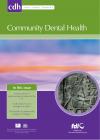Community Dental Health

- Cover Date:
- December 2010
- Print ISSN:
- 0265 539X
- Vol:
- 27
- Issue:
- 4
Trends in childrens’ ability to consent to a dental examination and the potential impact on reported caries indices
New guidance on consent for England and Wales suggests that children aged over 11 should be asked to consent to the NHS child dental survey examinations. If they are “Gillick competent†then they can provide consent. Whether they are “Gillick competent†is a matter of clinical judgment of the examining dentist. This paper explores the level of understanding expressed after the examination by children apparently “Gillick competentâ€. It considers issues how a dentist judges a child competent to make a decision to participate in a dental survey. Objective: The objective of this investigation was to examine the possible impact on reported DMFT indicators if children who have not fully understood an explanation of the nature and purpose of the survey could be identified by further questioning and excluded from the survey. This information will be helpful in making a decision on an appropriate threshold of competence used when obtaining consent from children participating in these NHS coordinated child dental surveys. Design and setting: Questionnaire data from the 2002/3 survey of 6,393 13-14 year-old children and the 2004/5 survey of 6,749 11-12 year olds were used. Questions were asked of participating children post-examination. The children were asked if they had actually understood the explanation provided before the examination of what was to be done and why. This information together with the NHS child dental DMFT data was analysed. Results: Approximately 15% of children in these age groups gave answers after the event which indicated that they had not understood either the nature or purpose of the survey. Deprived children were less likely to have understood an explanation and among 12 year olds the children who did not understand were more likely to have caries. There is potential for a small impact on DMFT indicators if higher thresholds of competence are used in future surveys. Conclusion: If different approaches to consent are used across England and Wales a small impact on DMFT indicators will result. Guidance on the judgment of capacity as part of the consent process will help to ensure comparability of data. A standard approach on consent method for use in NHS child dental surveys, in particular on how to judge competence, should be agreed.
Key words: Caries, consent, dental surveys, deprivation, DMFT, epidemiology,
- Article Price
- £15.00
- Institution Article Price
- £
- Page Start
- 200
- Page End
- 205
- Authors
- M.Z. Morgan, N. Monaghan
Articles from this issue
- Title
- Pg. Start
- Pg. End
- Editorial - Improvement of global oral health - the leadership role of the World Health Organization
- 194
- 199
- Trends in childrens’ ability to consent to a dental examination and the potential impact on reported caries indices
- 200
- 205
- Tooth surface loss, prevalence and associated risk factors among 12-14 years school children in Khartoum State, Sudan
- 206
- 212
- Trends in dental caries experience among children and adolescents in northern Poland between 1995 and 2003.
- 218
- 221
- Five-year follow-up of oral health and seizure condition of patients with epilepsy: a prospective observational study
- 233
- 237
- Distribution of certain types of occlusal anomalies among Saudi Arabian adolescents in Jeddah city
- 238
- 241
- Short Communication - The quality of reporting of randomised controlled trials in dental public health
- 253
- 256
